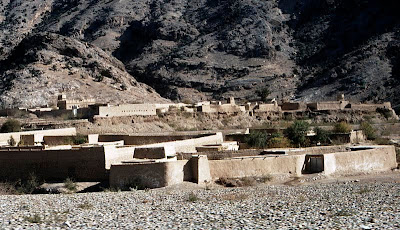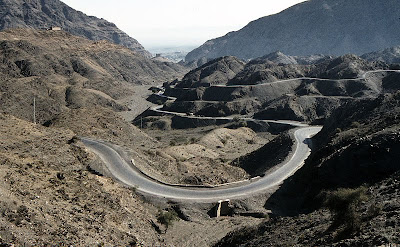
Travelling 3rd class by train, from Karachi on route to Peshawer, we had been befriended (and rescued) by Manzoor. He couldn’t do enough for us, putting us up for a night at his half-built house and then driving us around the North West Frontier and through the tribal area of Darra. Darra is a smuggling centre for guns, drugs and all black market goods. A real dive.
We were keen to see more of the ‘tribal lands’ and, if possible, the Khyber Pass while we were staying in Peshawer. However, the authorities were stopping all foreigners because Russian troops had been in the area the day before. No worries, Manzoor had lots of friends and one, ‘Princy’, knew a well respected ‘black-marketer’, an Afrida Headman and managed to smuggle us around a check point to this blokes house.
The tribal areas are scary places. They are virtually autonomous with a Wild West 'rule of the gun'. Manufacture and trading of arms and smuggling seemed the principal activity. Everyone armed to the teeth and living in fear.

The 'family strongholds' are mini-forts. Mud brick construction, with watch towers - forbidding places. On arrival at 'ours' Frances was taken away to cook chappattis with the women - us men fired a few rounds from the headman’s locally made 7mm rifle. (Frances, on hearing the shots, was convinced that I had been shot!)

The following day we left for the Khyber Pass proper with Princy and his friend. We were lucky to get there - thanks to our Afrida who was well known and persuaded the authorities. The Khyber Pass is a real fortress - both natural and full of Pakistan and old British gun emplacements. Smuggling tracks are everywhere. Mules are trained to make their own way across the border, loaded with goods.
Amazing place - from the top you could see the snow capped peaks of the Afghan hills
 During 6 months on a Galapagos Island, tagging turtles I had built up quite a relationship with some of the wildlife. A one legged Lava gull relied on my fishing for much of its sustenance, and a family of Pelicans sat next to me when I fished (nicking most of my catch).
During 6 months on a Galapagos Island, tagging turtles I had built up quite a relationship with some of the wildlife. A one legged Lava gull relied on my fishing for much of its sustenance, and a family of Pelicans sat next to me when I fished (nicking most of my catch). This had gone on several weeks when a storm threw up a bit of swell and I went out to enjoy a bit of body-surfing. To my surprise, Buck came in to join me. Tentative, at first, after a while he was surfing at my side, pushing me and steering me through the waves (probably horrified at my ineptness!). The ice was broken, and we enjoyed several more surfing sessions over the coming weeks until one day he decided to move on. I missed his company
This had gone on several weeks when a storm threw up a bit of swell and I went out to enjoy a bit of body-surfing. To my surprise, Buck came in to join me. Tentative, at first, after a while he was surfing at my side, pushing me and steering me through the waves (probably horrified at my ineptness!). The ice was broken, and we enjoyed several more surfing sessions over the coming weeks until one day he decided to move on. I missed his company

 The 'family strongholds' are mini-forts. Mud brick construction, with watch towers - forbidding places. On arrival at 'ours' Frances was taken away to cook chappattis with the women - us men fired a few rounds from the headman’s locally made 7mm rifle. (Frances, on hearing the shots, was convinced that I had been shot!)
The 'family strongholds' are mini-forts. Mud brick construction, with watch towers - forbidding places. On arrival at 'ours' Frances was taken away to cook chappattis with the women - us men fired a few rounds from the headman’s locally made 7mm rifle. (Frances, on hearing the shots, was convinced that I had been shot!) The following day we left for the Khyber Pass proper with Princy and his friend. We were lucky to get there - thanks to our Afrida who was well known and persuaded the authorities. The Khyber Pass is a real fortress - both natural and full of Pakistan and old British gun emplacements. Smuggling tracks are everywhere. Mules are trained to make their own way across the border, loaded with goods.
The following day we left for the Khyber Pass proper with Princy and his friend. We were lucky to get there - thanks to our Afrida who was well known and persuaded the authorities. The Khyber Pass is a real fortress - both natural and full of Pakistan and old British gun emplacements. Smuggling tracks are everywhere. Mules are trained to make their own way across the border, loaded with goods.
 At one stop at a village, some hopeful Dinka travellers tried to clamber onto the already crowded roof of the train. A bit of a barny ensued. The soldiers disembarked from the military carriage and lined the train to prevent any more attempts. The Dinks didn’t much like being told what to do by the Sudanese (Arab) army. One shot a guard with his home made rifle. Only a slight cut on the head but the tense stand-off lasted for several hours. Spear wielding Dinks lined up against rifle toting army, glaring at each other.
At one stop at a village, some hopeful Dinka travellers tried to clamber onto the already crowded roof of the train. A bit of a barny ensued. The soldiers disembarked from the military carriage and lined the train to prevent any more attempts. The Dinks didn’t much like being told what to do by the Sudanese (Arab) army. One shot a guard with his home made rifle. Only a slight cut on the head but the tense stand-off lasted for several hours. Spear wielding Dinks lined up against rifle toting army, glaring at each other.  The Chief and Elders at the village of Tabaan suggested we might all enjoy a ‘Bush Roast’ to celebrate the new hand-pump that we had installed. Consequently, I joined a small hunting party armed with nets and spears. We spent all night and caught one baboon (well, I didn’t, they wouldn’t trust me to do anything but watch)
The Chief and Elders at the village of Tabaan suggested we might all enjoy a ‘Bush Roast’ to celebrate the new hand-pump that we had installed. Consequently, I joined a small hunting party armed with nets and spears. We spent all night and caught one baboon (well, I didn’t, they wouldn’t trust me to do anything but watch) The following morning, They set up a rush screen in the village ‘green’ to shield a shallow bowl of water to allow me to wash. With the privacy of the screen, I stripped off for a full (and much needed) body wash – unfortunately, I slipped on the soap, crashed through the screen, and, to the delight of the entire village that had gathered to watch, lay sprawled naked (and very white).
The following morning, They set up a rush screen in the village ‘green’ to shield a shallow bowl of water to allow me to wash. With the privacy of the screen, I stripped off for a full (and much needed) body wash – unfortunately, I slipped on the soap, crashed through the screen, and, to the delight of the entire village that had gathered to watch, lay sprawled naked (and very white).






